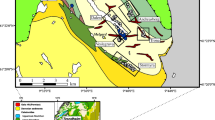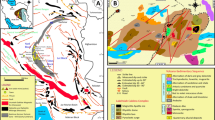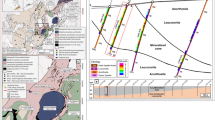Abstract
The Suwałki anorthosite massif, located in extreme northeast Poland beneath more than a kilometer of Phanerozoic cover, hosts major Fe-Ti-V deposits. These deposits, discovered in 1962, are contained in Fe and Ti oxide minerals that coexist with subordinate quantities of Fe, Cu, Ni, and Co sulfides in massif-style anorthosites, norites, and gabbronorites. Accessibility and other considerations preclude development of this natural resource in the present economic climate. Detailed work by Polish geologists during the last 35 years provides a sound geologic framework for this Re-Os study of the age and origin of oxide and sulfide deposits associated with a major, but lesser known anorthosite massif. Rhenium and osmium abundances and Os isotopic compositions were measured for nine sulfides and four titanomagnetites from the Suwałki anorthosite massif. The titanomagnetites are over an order of magnitude lower in Re (0.4–1.5 ppb) and Os (0.036–0.144 ppb) concentrations than co-precipitated pyrrhotite, pyrite, and chalcopyrite that yield consistent concentrations for Re (30–55 ppb) and Os (1–6 ppb). Parallel lines connecting co-existing titanomagnetite and sulfides have slopes of ∼1 on Re versus common Os concentration plots, indicating that both Re and Os behave similarly during crystallization in their high preference for any sulfide phase over magnetite. Samples from three deposits within the anorthosite massif were analyzed. An age of 1559 ± 37 Ma (n=10) with an initial 187Os/188Os of 1.16 ± 0.06 for the Jezioro Okrągłe and Krzemianka deposits is essentially identical to an age of 1556 ± 94 Ma (n=3) for the Udryń deposit. Udryń, however, yielded a marginally lower initial 187Os/188Os of 0.87 ± 0.20. The high initial 187Os/188Os combined with the Proterozoic Re-Os age indicates that the source for Suwałki oxides-sulfides is older crust, and hypothetically, could involve Archean rocks. An average crustal value of 50 for 187Re/188Os yields a 2777 Ma age for Suwałki source rocks. Widespread Phanerozoic cover severely limits knowledge of basement rocks in Poland, however, and no Archean rocks are known in the immediate region. More likely, 187Re/188Os ratios may be higher than average continental crust, reflecting mafic crust in the source, and may move the source age for Suwałki anorthosite and mineral deposits toward younger values that easily include ∼2.0 Ga Proterozoic rocks. This more favorable case also accommodates Paleoproterozoic Nd model ages. Regardless of Archean or Proterozoic source age, the high initial 187Os/188Os ratios derived from the Re-Os isochron indicate that the source for the oxide-sulfide mineral deposits is more likely the crust and not the mantle. Given that these deposits are clearly magmatic, the Re-Os results add a new dimension to the long-standing “origin of anorthosite” problem, implying a crustal source for the anorthosite as well. The 1559 Ma Suwałki age is compatible with a well-exposed east-west band of 1530-1660 Ma rapakivi granite-anorthosite magmatism to the immediate north, transecting western Russia, southern Finland, Estonia and Latvia, and central Sweden. In particular, the age and isotopic character of Suwałki are not unlike those of the well-studied Salmi rapakivi granite-anorthosite batholith in western Russia (Karelia).
Similar content being viewed by others
Author information
Authors and Affiliations
Additional information
Received: 4 December 1998 / Accepted: 11 November 1999
Rights and permissions
About this article
Cite this article
Morgan, J., Stein, H., Hannah, J. et al. Re-Os study of Fe-Ti-V oxide and Fe-Cu-Ni sulfide deposits, Suwałki Anorthosite Massif, northeast Poland. Mineral. Deposita 35, 391–401 (2000). https://doi.org/10.1007/s001260050251
Issue Date:
DOI: https://doi.org/10.1007/s001260050251




